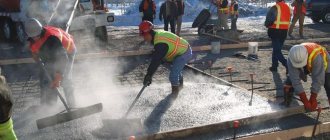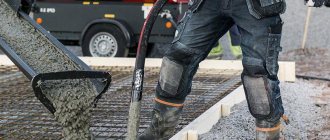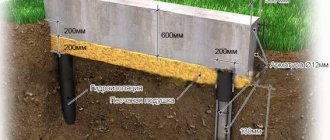Beton-House.com
Website about concrete: construction, characteristics, design. We combine the experience of professionals and private craftsmen in one place
compaction process
Vibrating concrete is one of the effective methods of compacting concrete mortar during the period of pouring it into the formwork of structures.
The main characteristics of concrete, such as uniformity of structure, strength, durability, are laid down at the stage of concrete work. One of the technological factors influencing the further operational characteristics of structures is the mandatory vibration of the composition during the formation or construction of a reinforced concrete monolith.
- Deep vibrators Electromechanical device
- Area surface vibrators
Description of vibration as a method of strengthening concrete
The liquid pulp of cement mortar, when mixed in a concrete mixer, absorbs up to 2% of the air from the volume of the mixture. If it is allowed to remain in the concrete, it will create a porous, loose stone when it hardens. The durability of a structure based on such concrete is lost even when using high grade cements: the mass will be riddled with capillaries and voids, just like a sponge will absorb water and crack in winter. The unmixed solution will most likely harden in layers and will also begin to fall off in layers.
Vibrating the solution solves both of these problems. The tip of the vibrator, oscillating at high frequency and low amplitude within a radius of action depending on the power of the device, shakes the pulp, causing dissolved air to collect in bubbles and come to the surface. Thus, the concrete mass gets rid of air dissolved in it. The mass of the solution excited by vibrations acquires increased fluidity, the solution mixes better, without forming layers and uniformly filling the volume intended for it.
Freed from excess air, the concrete stone, homogeneous throughout the entire mass, becomes resistant to all influences: mechanical, climatic and seasonal.
Process Benefits
The compaction process in concrete has a number of advantages:
- Vibration reduces the porosity of concrete stone. As is known, voids in liquid pulp account for 1-2%. If they are not removed, they will fill with air and the cement will lose strength and water resistance. Vibration effects can solve this problem. High-frequency mechanical vibrations with low amplitude increase the mobility of the liquid pulp, which causes the outflow of air bubbles.
- Vibration vibrations make it possible to increase the viscosity of the sand concrete mass and prevent delamination. Thus, the finished concrete stone will be more uniform. In addition, oscillatory movements increase the fluidity of the liquid mass, which allows it to more evenly fill the formwork shape. Vibrating concrete allows you to obtain a ready-made product that is resistant to cracking, mechanical stress, seasonal temperature fluctuations and other negative environmental factors, with an increased service life.
Return to contents
Vibration methods
Before pouring the concrete solution, it is necessary to thoroughly clean the reinforcement frame from oil and rust and check the strength of the formwork. Filling must be done in such a way that separation of the solution does not occur, sequentially laying the mixture in one direction.
Vibrating concrete can be done manually or mechanically.
Manual vibration
If there is no tool for mechanical vibration, for small volumes of work in inconvenient places, carefully tap the reinforcement and formwork, thus exciting vibrations of the solution. This must be done without fanaticism, trying not to damage the formwork.
Liquid pulp can also be pierced to its full depth with a piece of reinforcement or a crowbar: the more often, the better. Both of these methods can be used where the use of mechanical vibrators is impossible or impractical. These methods will not give very good results, but with sufficient diligence they will be useful in country and home construction.
Mechanical vibration
For more plastic mixtures and for large volumes of work, deep mechanical vibrators with flexible tips are used.
When carrying out high-quality vibration of concrete, you must follow the following rules:
- immersion of the tip (club) of the vibrator into the solution no more than 80% of its length. This is necessary so that the upper surface of the layer does not stagnate and does not inhibit the release of air bubbles;
- the circles from the vibrator on the surface of the solution must overlap by at least 10 cm, or the tip must be moved in increments of 1.5 radii of the circle. The main rule is that there should be no laying areas not covered by waves;
- when laying concrete in layers, the tip of the vibrator must pass below the interface by at least 10 cm, thereby destroying the delamination of the monolith;
- It is not recommended to touch the reinforcement and formwork with the tip; you should not bring it close to joints and corners, so as not to damage it and disrupt the structure;
- The vibrator must be immersed in the solution quickly and removed slowly so that the funnel tightens;
- After vibration is completed, the next layer of concrete can be laid, but the reinforced layer must not be allowed to set.
The end of vibration can be determined by the following signs: there is no subsidence of the pulp, the top layer has stopped bubbling, cement laitance has floated to the surface.
More details about all measures for vibrating concrete mortar are written in the builder’s handbook SNiP 3.03.01-87 clause 2.11 [1].
Vibration Process Stages
The solution is compacted using a tool or vibrating platform. The resulting impulses dilute the liquid and remove air bubbles. The type of equipment determines the frequency of oscillations, the indicator of which is considered the main parameter of the process. It would be advisable to use several devices that have the same frequency. Then the process of concrete compaction will become more uniform. Main points of work:
- First, you should pour a uniform layer of concrete no more than 40 cm high.
- Start vibrating in one place for more than 5 seconds. If the concrete density is high, increase the time.
- Remove the vibrator slowly.
Equipment used for vibration
The physical and mechanical characteristics of the necessary equipment for vibrating a particular object are initially determined by the aggregate fraction and the quality of the solution. Conventionally divided into three types:
- for aggregate with a fraction of less than 10 mm and fine-grained mortar, the required operating frequency of the vibrator tip is from 10 to 20 thousand vibrations per minute;
- for fractions from 10 to 50 mm frequency – from 3500 to 9000 vibrations;
- frequencies less than 3.5 thousand are the most common and effective in all cases.
The speed and quality of vibration also directly depends on the length and diameter of the tip, which in turn determine the drive power of the mechanism. By type of drive, the equipment can be electric (from an electric motor), pneumatic (from a compressor valve) and gasoline (from an internal combustion engine). The design of the flexible transfer shaft and the set of tips depends on the manufacturer of the particular device.
In addition to the mechanical vibrator, controlled by the operator, there are a large number of machines for use on large volumes of concrete to be consolidated. They are divided into the following classes:
- various vibrating plates and vibrating laths for processing the top layer of mortar over large areas. They can be equipped with various tools for vibrating the top and bottom of the concrete being compacted (weights), additional vibrating attachments and devices for smoothing and additional compaction of cement.
- for the production of massive reinforced concrete structures, deep-depth machines with complete immersion in the solution;
- volumetric vibrating platforms with moving frames and blocks for supplying horizontal and vertical vibrations to the solution.
The tasks of all the variety of machines and mechanisms are the same - to remove air from the solution and compact the concrete by vibration.
Along with traditional mechanical vibrators, equipment has recently begun to appear that uses ultrasound to compact concrete. Such devices consist of formwork panels with powerful piezoceramic emitters, which are powered by an ultrasound generator, a thyristor switch, and controlled by a computer.
Ultrasonic submersible deep vibrators and external emitters mounted on formwork panels are rearranged, like traditional mechanical ones, as concrete is laid in increments of one and a half radii of effective radiation. The disadvantages of this technology include the low quality of compaction, high energy costs and high labor intensity, but the technique is being developed and is quite successfully used in monolithic construction using sliding equipment [2].
Deep vibrators
For vibration quality, the tool should be immersed to the entire depth of the concrete layer.
The most common type of vibrator is the deep one. It consists of a club with an eccentric, which is connected by a flexible shaft to a motor. The mace is immersed in the mixture and acts on it with certain forces, hence the name - deep. The vibration frequency of the mixture reaches 12,000 cycles per minute. The vibrator moves easily and processes areas within a radius of up to a meter within 15-30 seconds. The moment of completion of the process can be determined by the surface: it should not contain excess solution and should not be porous .
The vibrator must be immersed to the entire depth of the concrete and into the layer located below, if it is still plastic. This will eliminate the contact zone and create monolithic concrete. If the layer thickness is more than 0.6 m, then the vibrator will not be able to remove air from the lower parts of the layer. These types of vibrators are very effective because all their energy is completely transferred to the mixture.
Do-it-yourself preparation and vibration
If you have a strong desire to pour concrete with your own hands for personal construction and have no experience, you must carefully study SNiP 3.03.01-87 and watch videos on the relevant topic. If the quality of tapping the formwork and baying the mortar is not satisfactory, carefully consider the following options:
- searching for a suitable vibrator on the Internet to complete the task;
- If you don’t want to buy a device for a one-time job, try renting it from a tool store or through the appropriate forums;
- if you have a drill or hammer drill, you can build a makeshift tip (if you have enough experience working with your hands, this is a completely feasible task), you can also look for a set of tips with a flexible drive for rent;
- You can make a quite decent vibrator for home construction from almost any electric motor from household appliances, fortunately there are enough drawings and recommendations on the Internet.
By scrupulously following the recommendations for vibrating the cement mortar, a homemade device can quite adequately cope with the high-quality strengthening of concrete.
Pores and capillaries weakening concrete
Concrete is initially an aqueous solution of cement, sand and additives. The water located between the grains of sand and other aggregates evaporates during the solidification process, forming capillary pores in the mass. Their sizes can be much less than a micron or reach hundreds of microns.
The process occurring under the aggregate grains (sedimentation) leads to the evaporation of water. As a result, sedimentation pores more than 2 mm in diameter are formed under them (depending on the size of the aggregate fractions).
In addition, when mixing in a concrete mixer, the solution may additionally collect air bubbles. In total, all types of air in an uncompacted solution can reach 6% of the mass of the concrete mixture. If you allow concrete to harden in this state, the quality of the stone will deteriorate significantly.
Signs of sufficient compaction of the concrete mass
One of the signs is the absence of bubbles in the concrete mixture. Compaction work with concrete can be carried out in two ways: manually and mechanically. However, it is difficult to achieve good results with manual compaction. Vibration is also not always possible to obtain the required homogeneity. On the one hand, the mixture may not be completely compacted, and on the other hand, it may delaminate due to excessive vibration. This can be avoided by achieving sufficient rigidity of the composition and selecting the optimal particle size distribution of the fractions. These options vary depending on the vibration device selected.
The degree of compaction can be correctly determined using several parameters:
- there is no settling of liquid conglomerate;
- laitance with sand floats to the surface;
- there are no air bubbles;
- After removing the vibrator nozzle, the surface of the conglomerate quickly closes.
Return to contents











